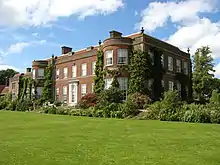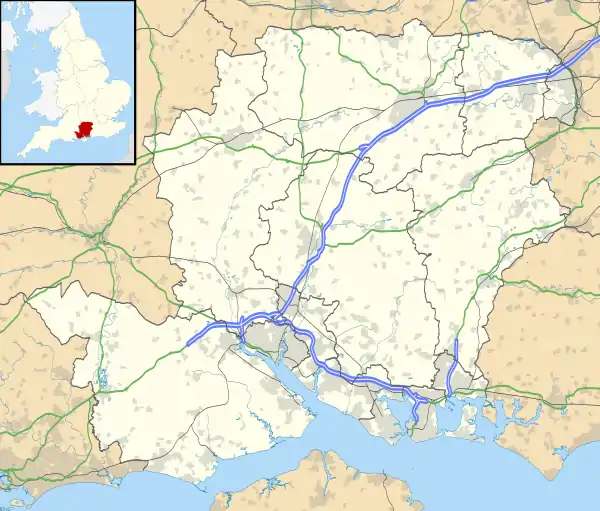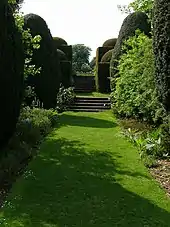Hinton Ampner
Hinton Ampner House is a country house and estate with gardens within the civil parish of Bramdean and Hinton Ampner, near Alresford, Hampshire, England. It is a Grade II listed building.[1]
| Hinton Ampner | |
|---|---|
 Garden front of house | |
| Type | Country house |
| Location | Bramdean and Hinton Ampner |
| Coordinates | 51°02′37″N 1°09′03″W |
| OS grid reference | SU 59639 27483 |
| Area | Hampshire |
| Built | 1790 |
| Architect |
|
| Architectural style(s) | Neo-Georgian |
| Owner | National Trust |
Listed Building – Grade II | |
| Official name | Hinton Ampner House |
| Designated | 5 December 1955 |
| Reference no. | 1095121 |
 Location of Hinton Ampner in Hampshire | |
The house and garden are owned by the National Trust and are open to the public.[2][3]
History

The garden was created by Ralph Stawell Dutton (1898–1985), the 8th and last Baron Sherborne, starting in 1930, making this a modern 20th-century garden.[4] The property is now more noted for its garden than the house. Previously, the parkland came directly up to the house, which was designed to be a hunting lodge. An earlier Tudor house stood close to the current site, before the present-day house was built.
Hinton Ampner was built in 1790 but remodelled extensively in 1867. It was remodelled again in the Neo-Georgian style by Trenwith Wills and Lord Gerald Wellesley for Ralph Dutton between 1936 and 1939 to his vision of what it would have been like had it been built on its current scale in 1790 – a Georgian country house.[5] It was badly damaged by fire in 1960, and restored again much as it had appeared in 1936.
The house contains a number of fine paintings. There is a set of paintings of the four seasons by Jacob de Wit, depicting cherubs painted in a three-dimensional monochrome style.
Ralph Dutton, with no direct heirs, gave the estate to the National Trust, on his death in 1985.
Poltergeist claims
The old Tudor house attained notoriety, in the 18th century, after it was said to have become uninhabitable due to loud noises attributed to a poltergeist. One tenant, Mary Ricketts, wrote about her experiences in the house.[6] That house was pulled down in 1793, after its replacement had been built about 50 metres (160 feet) to the south. Harry Price citing Ricketts' statements wrote at length about the case in his book Poltergeist Over England (1945).
Claims about the poltergeist were disputed by Trevor H. Hall who suggested that "underground water was mainly responsible for the noises at Hinton, although the account of some of them is highly suggestive of seismic disturbance."[7]
References
- Historic England. "Hinton Ampner House (1095121)". National Heritage List for England. Retrieved 22 March 2019.
- "Hinton Ampner". The National Trust. Retrieved 27 June 2020.
- Hinton Ampner. The National Trust, 2008. ISBN 978-1-84359-291-4
- "The garden at Hinton Ampner". The National Trust. Retrieved 27 June 2020.
- Cruickshank, Dan (Summer 2012). "Wills and Wellesley". National Trust Magazine: 38.
- Clarke, Roger (2012). A Natural History of Ghosts. Particular Books. pp. 35–69. ISBN 978-1-846-14333-5.
- Hall, Trevor H. (1958). Four Modern Ghosts. Duckworth. p. 22
External links
| Wikimedia Commons has media related to Hinton Ampner House. |
- Hinton Ampner – official site at National Trust
- Map sources for Hinton Ampner
- A Natural History of Ghosts – a history of the haunting of the house
